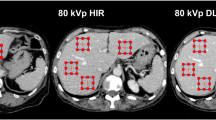Abstract
Objectives
To (a) evaluate the interpolation frames of frame rate conversion (FRC) compared with fluoroscopic frames of conventional method, and (b) compare radiation dose and fluoroscopy time between various clinical examinations without and with FRC retrospectively.
Methods
This study consisted of a basic study and a clinical retrospective analysis. The radiation dosimetry, visual assessment and measurements of contrast to noise ratio were examined. Similarity between interpolation frames and fluoroscopic frames was evaluated using normalised cross-correlation values. In the clinical retrospective analysis approved by the institutional review board, we extracted 270 examinations performed without FRC (conventional group, 12.5 pulses/s) and with FRC (FRC group, 6.25 pulses/s) from 23 May to 31 December 2016. The fluoroscopy parameters and demographics of the two groups of the clinical examinations were compared. Statistical analyses were performed with Wilcoxon signed-rank test, Brunner–Munzel test and χ2 test.
Results
In the basic study, the only significant difference was that the radiation dose of FRC was approximately half that of the conventional method in the same fluoroscopy time (p = .031). The interpolation frames of FRC were similar to the fluoroscopic frames of the conventional method. In the clinical retrospective analysis, the only significant difference was that FRC reduced the fluoroscopy dose by 48% and the total dose by 31% compared with the conventional method (p < .001). There was no significant difference in the others.
Conclusion
FRC significantly reduced the radiation dose without extending the fluoroscopy time and maintaining the image quality compared to the conventional method.
Key Points
• Although X-ray fluoroscopic techniques are widely used for various clinical purposes, X-ray fluoroscopic examinations have radiation risks.
• Frame rate conversion is an image processing technique for radiation dose reduction.
• Clinical retrospective analysis showed that FRC reduces radiation doses of patients.




Similar content being viewed by others
Abbreviations
- CNR:
-
Contrast to noise ratio
- DAP:
-
Dose area product
- FPD:
-
Flat panel detector
- FRC:
-
Frame rate conversion
- NCC:
-
Normalised cross-correlation
References
Berrington de González A, Darby S (2004) Risk of cancer from diagnostic X-rays: estimates for the UK and 14 other countries. Lancet 363:345–351
Shope TB (1996) Radiation-induced skin injuries from fluoroscopy. Radiographics 16:1195–1199
Berlin L (2001) Radiation-induced skin injuries and fluoroscopy. AJR Am J Roentgenol 177:21–25
Aroua A, Rickli H, Stauffer JC et al (2007) How to set up and apply reference levels in fluoroscopy at a national level. Eur Radiol 17:1621–1633
Justino H (2006) The ALARA concept in pediatric cardiac catheterization: techniques and tactics for managing radiation dose. Pediatr Radiol 36:146–153
Linke SY, Tsiflikas I, Herz K, Szavay P, Gatidis S, Schäfer JF (2016) Ultra low-dose VCUG in children using a modern flat detectorunit. Eur Radiol 26:1678–1685
Weis M, Hagelstein C, Diehm T, Schoenberg SO, Neff KW (2016) Comparison of image quality and radiation dose between an image-intensifier system and a newer-generation flat-panel detector system—technical phantom measurements and evaluation of clinical imaging in children. Pediatr Radiol 46:286–292
Miraglia R, Maruzzelli L, Cortis K et al (2015) Comparison between radiation exposure levels using an image intensifier and a flat-panel detector-based system in image-guided central venous catheter placement in children weighing less than 10 kg. Pediatr Radiol 45:235–240
Morishita J, Katsuragawa S, Kondo K, Doi K (2001) An automated patient recognition method based on an image-matching technique using previous chest radiographs in the picture archiving and communication system environment. Med Phys 28:1093–1097
Morishita J, Katsuragawa S, Sasaki Y, Doi K (2004) Potential usefulness of biological fingerprints in chest radiographs for automated patient recognition and identification. Acad Radiol 11:309–315
Toge R, Morishita J, Sasaki Y, Doi K (2013) Computerized image-searching method for finding correct patients for misfiled chest radiographs in a PACS server by use of biological fingerprints. Radiol Phys Technol 6:437–443
Kundel HL, Polansky M (2003) Measurement of observer agreement. Radiology 228:303–308
Schernthaner RE, Duran R, Chapiro J, Wang Z, Geschwind JF, Lin M (2015) A new angiographic imaging platform reduces radiation exposure for patients with liver cancer treated with transarterial chemoembolization. Eur Radiol 25:3255–3262
Söderman M, Holmin S, Andersson T et al (2013) Image noise reduction algorithm for digital subtraction angiography: clinical results. Radiology 269:553–560
Söderman M, Mauti M, Boon S, Omar A, Marteinsdóttir M, Andersson T et al (2013) Radiation dose in neuroangiography using image noise reduction technology: a population study based on 614 patients. Neuroradiology 55:1365–1372
Perisinakis K, Raissaki M, Damilakis J, Stratakis J, Neratzoulakis J, Gourtsoyiannis N (2006) Fluoroscopy-controlled voiding cystourethrography in infants and children: are the radiation risks trivial? Eur Radiol 16:846–851
Acknowledgements
In our basic study, the image reconstruction from the raw data which includes no clinical information was supported by Hitachi Ltd. Healthcare Business Unit.
Funding
This work was partially supported by a Grant-in-Aid from JSPS (Japan Society for the Promotion of Science) KAKENHI JP Scientific Research (C) Grant Number 15K08692.
Author information
Authors and Affiliations
Corresponding author
Ethics declarations
Guarantor
The scientific guarantor of this publication is Noriyuki Sakai.
Conflict of interest
The authors of this manuscript declare no relationships with any companies whose products or services may be related to the subject matter of the article.
Statistics and biometry
No complex statistical methods were necessary for this paper.
Informed consent
Written informed consent was waived by the institutional review board.
Ethical approval
Institutional review board approval was obtained.
Methodology
• retrospective
• observational and experimental
• performed at one institution
Rights and permissions
About this article
Cite this article
Sakai, N., Tabei, K., Sato, J. et al. Radiation dose reduction with frame rate conversion in X-ray fluoroscopic imaging systems with flat panel detector: basic study and clinical retrospective analysis. Eur Radiol 29, 985–992 (2019). https://doi.org/10.1007/s00330-018-5620-y
Received:
Revised:
Accepted:
Published:
Issue Date:
DOI: https://doi.org/10.1007/s00330-018-5620-y




